The blazer is an iconic piece of menswear as well as a central piece of any gentleman’s wardrobe. Unfortunately, the definition of a “blazer” has gotten hazier over time.
To make sure you’re taking advantage of the blazer’s remarkable versatility, we will define a blazer, discuss its history, modern interpretations of the jacket and elaborate on how to wear it best.
What is a Blazer?
Let us start by first addressing the most vexing question – what exactly is a blazer? One might be tempted to think it is any jacket that happens to be worn without matching pants. The Oxford American Dictionary describes it as a “sports jacket not worn with matching trousers.”
Meanwhile, the Oxford English Dictionary describes it as “a coloured jacket worn by schoolchildren or sports players as part of a uniform” or “a plain jacket not forming part of a suit but considered appropriate for formal wear.” The Free Dictionary describes it as “A lightweight, often striped or brightly coloured sports jacket having pockets and notched lapels.” And the Merriam-Webster dictionary describes it as “a jacket that is worn over a shirt and that looks like a suit jacket but is not part of a suit.” Clear as mud, eh?
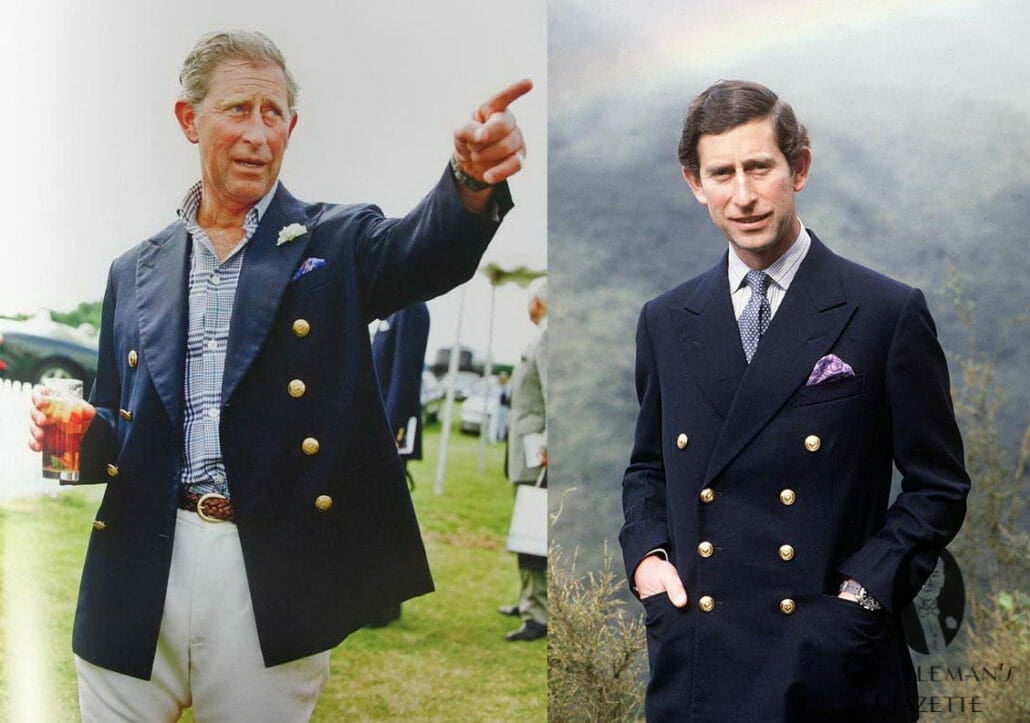
The 8 Characteristics of a Blazer
Clearly the various dictionaries are neither very specific nor complete, but a few things can be inferred from men’s clothing encyclopedias and from our assumptions of what a blazer is. In many countries, the term “blazer” is synonymous for any jacket, especially in womenswear, but for the purpose of this article, we will use the technical definition of a blazer:
- A standalone jacket worn with trousers of a contrasting color, pattern or material.
- It is solid colored or has bold, vividly colored stripes
- Solid colors are almost exclusively a shade of navy blue, but can include othe solid colors such as bottle green, white or red.
- May have contrasting piping, braiding, or trim.
- Comes in double-breasted 6×2, 6×3, 8×3 configurations, or single-breasted with one to three buttons.
- The buttons are one of the two distinctive features of a blazer – usually buttons are made of contrasting mother of pearl, silver, pewter, brass or gilt embossed with anchor and a scroll (Nelson buttons) or a crest/logo of the school, college, club, sports team, or association.
- In some cases, the second distinctive feature is the presence of the crest or badge of the school, college, club, sports team, association, etc. as the case may be on the breast pocket. The crest/badge often denotes the wearer’s individual position within the specific organization.
- The jacket is usually made of navy blue serge; hopsack, worsteds or wool flannel are classic alternatives, while fresco or linen are used for warmer weather. Striped blazers are often made of wool flannel or cotton.
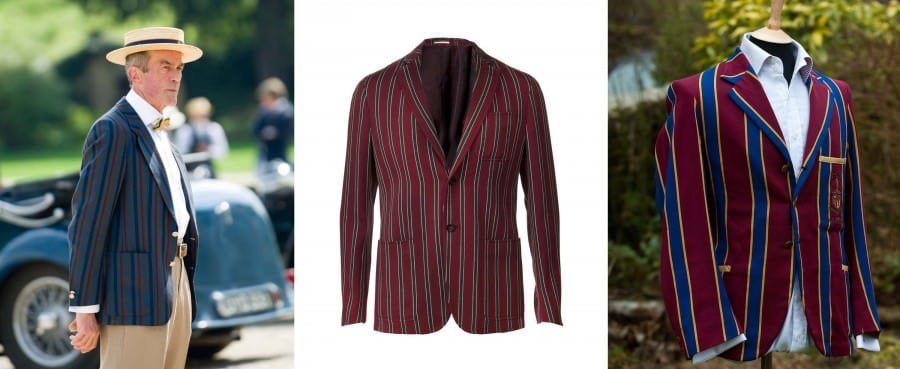
History of the Blazer
If rightly describing the characteristics of the blazer was a daunting task, tracing its history proves to be no less difficult. There seem to be multiple theories of how the blazer got its name, with one source listing as many as ten! However, to narrow things down, the blazer as we know it today seems to have evolved from two origins.
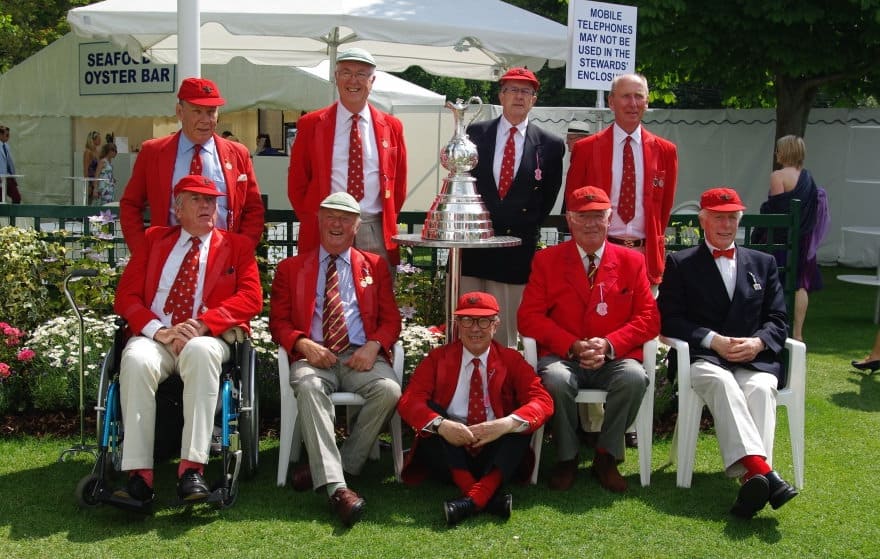
Blazer Origin No. 1 – Lady Margaret Boat Club
Members of the Lady Margaret Boat Club (founded in 1825 by twelve members of St. John’s College, Cambridge) wore bright, scarlet red-colored flannel jackets, and since they blazed they were named blazers. The club still exists today and keeps with the same tradition. Interestingly, gold buttons as well as piping are only reserved for certain members. Those with First May Colors are entitled to wear piping and have gold buttons on their blazer while First Lent or Second May Colors are entitled to wear silver buttons on their blazer only.
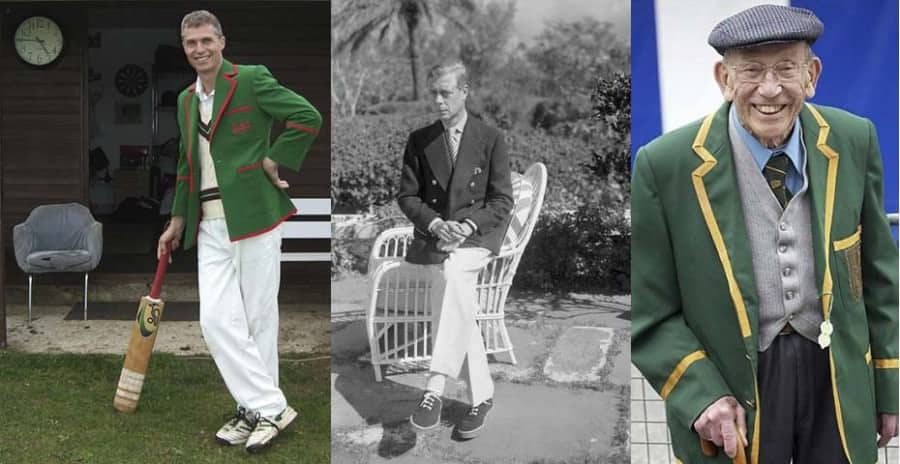
Gradually the term was used to denote jackets with a similar association – much to the annoyance of the purists of the day, which can be seen in this spirited response from a reader of the London Daily News in 1889:
“In your article of to-day‥.you speak of ‘a striped red and black blazer’, ‘the blazer’, also of ‘the pale toned’ ones.‥ A blazer is the red flannel boating jacket worn by the Lady Margaret, St. John’s College, Cambridge, Boat Club. When I was at Cambridge, it meant that and nothing else. It seems from your article that a blazer now means a colored flannel jacket, whether for cricket, tennis, boating or seaside wear.”
In hindsight, we know that he lost the battle!
The second story of how the blazer got its name is probably the more popular one, although the timeline suggests that it is the latter of the two. In 1837, Queen Victoria decided to carry out an inspection of one of the vessels of the Royal Navy, named the H.M.S. Blazer. In his effort to impress the Queen, the Commander of the H.M.S Blazer decided to get new uniforms for his men as he felt that the current uniforms were hideous. After much deliberation, he settled on an outfit that included a double-breasted jacket with brass Royal Navy buttons. It deserves mentioning that in those days standard uniforms for sailors in the Royal Navy did not exist, and many Commanders established their own standards of appearance for their sailors with little or no uniformity between ships. Sailors on the H.M.S. Blazer continued to wear jackets of blue and white stripes until at least 1845 before the sailors’ uniforms were standardized in 1857.
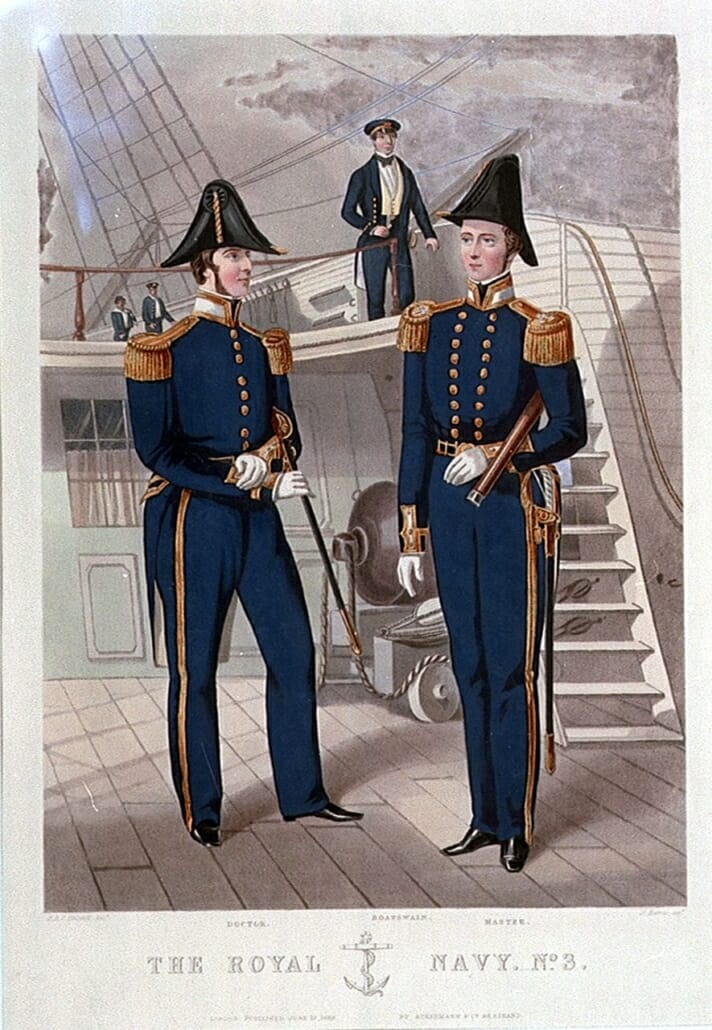
By or before 1889, the term blazer seems to have acquired its modern meaning, as is apparent from the article in the London Daily News. It remains unknown when exactly it became part of the uniform of many schools and colleges throughout the British Empire. School blazers today come in a wide range of colors, some with piping but most without, but always with the school badge and school buttons. Special badges or piping in ‘School Colors’ are awarded to students for certain achievements and sets them apart from the others. Many gentlemen’s clubs, especially sports and boating clubs, also have a similar system and these blazers are known as Club Blazers.
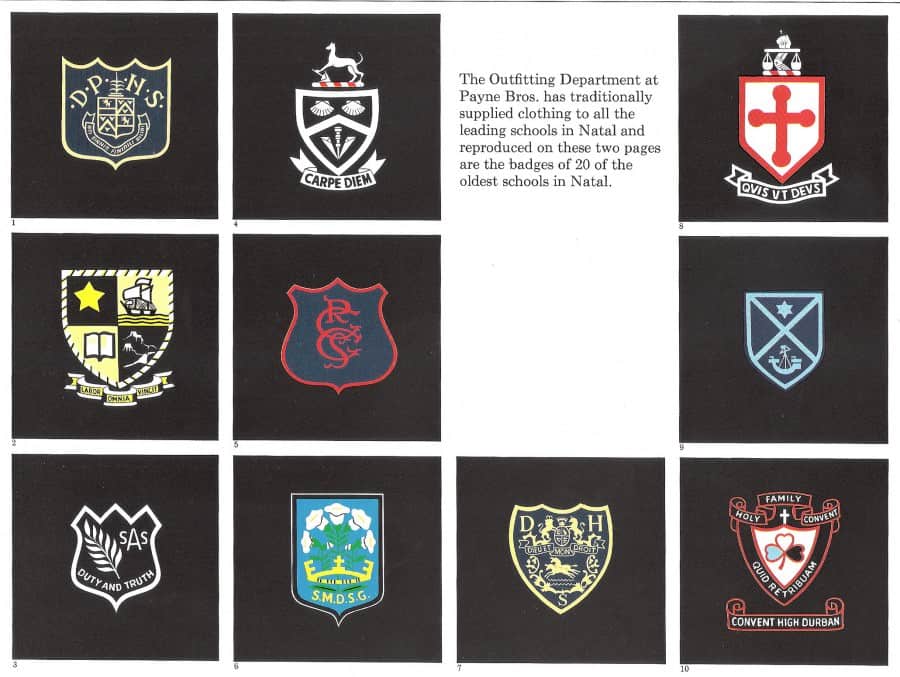
In the British Army and many armies of the Commonwealth nations, many Regimental Associations have their own blazers that are called Regimental Blazers. They usually come complete with Badge and regimental buttons and the colors, etc., vary from association to association. These are veteran associations and serving officers do not wear them (they stick to their various uniforms). Traditionally, Grenadier Guards blazers feature only one cuff button, Coldstream Guards two, Scots Guards three, Irish Guards four and Welsh Guards five cuff buttons.
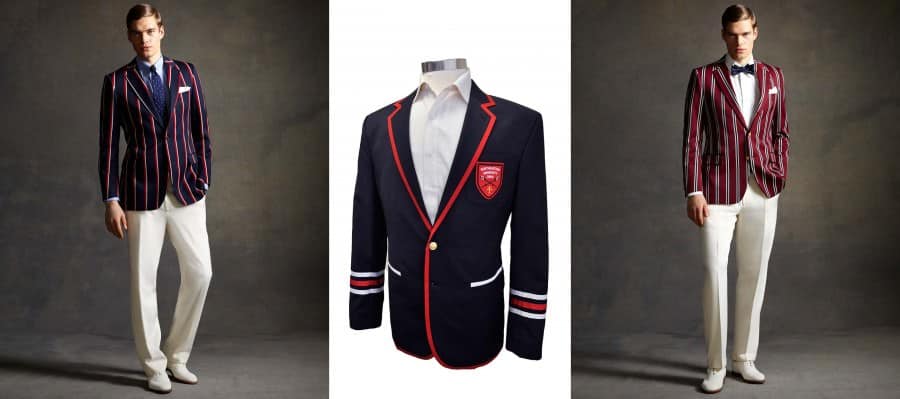
In this context the blazer could be considered a bit elitist as only members of these associations (which were elitist in varying degrees) were eligible to wear them. Fortunately, that’s not the case anymore. The striped blazer was popular with dandies in the 1910s and 1920s, especially in the U.S., where Brooks Brothers was a major purveyor of striped blazers. Subsequently, it was adopted by the British Mods in the 1960s and became very popular among the fashionable younger set.
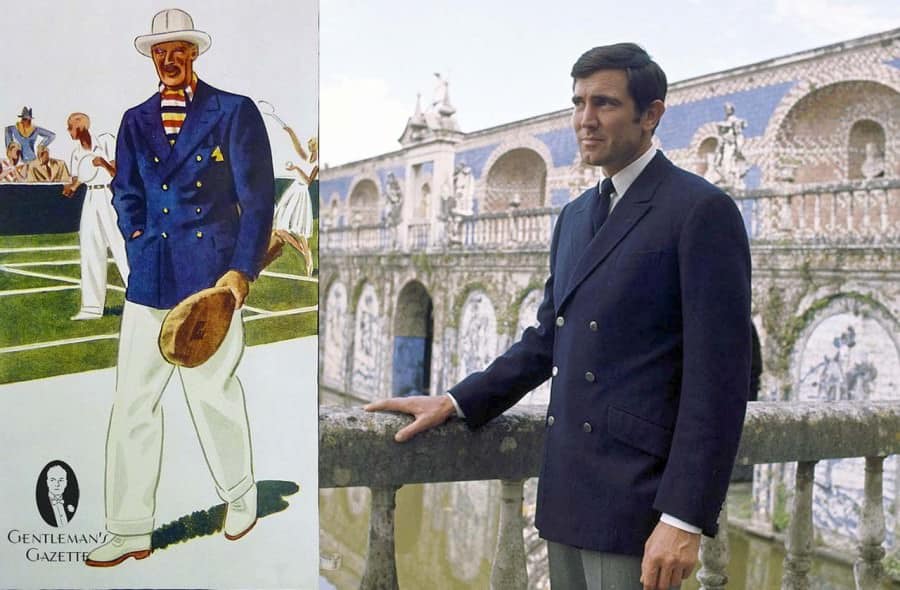
The blazer was also commonly associated with traditional gentlemen’s sports, once again adding to the elitist perception, however nowadays this has also almost disappeared, persisting only in cricket (and very occasionally on the tennis court), where it is considered customary for the captains to wear blazers with their team’s logo or national coat of arms during the tossing of the coin at the beginning of test matches.

However in two sporting events today blazers continue to signify victory, theses being the Masters Golf Tournament in Augusta, Georgia and the Congressional Cup Regatta at the Long Beach Yacht Club. A green and a crimson blazer are awarded to the winners in these respective events.
Rowing or Regatta Blazers
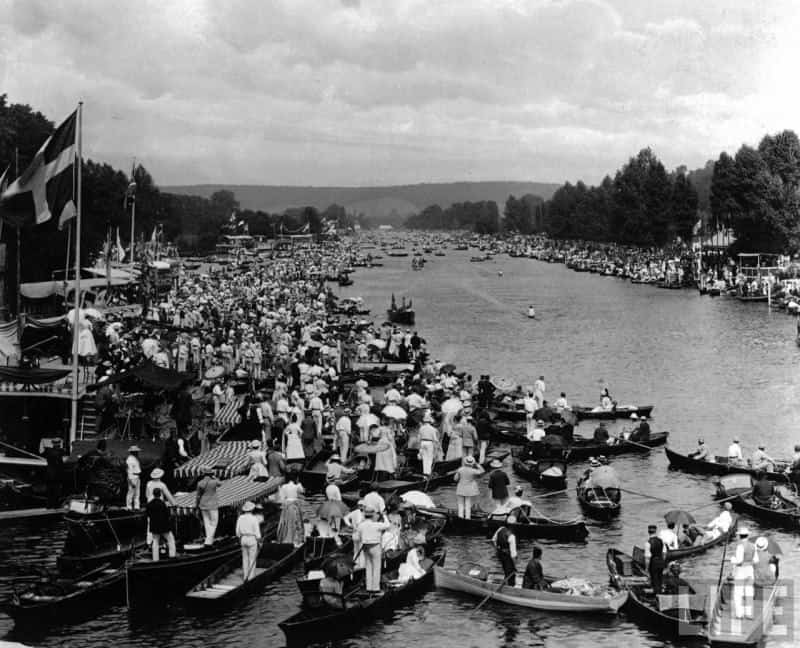
Today, the Henley Royal Regatta is probably the best event for blazer lovers and wearers worldwide. If you can’t make it, you should invest in the beautiful coffee table book Rowing Blazers by Jack Carlson with pictures by F.E. Castleberry, which is full of information about this kind of bold, striped of braided blazers. Find a selection of various boating blazer variations below.
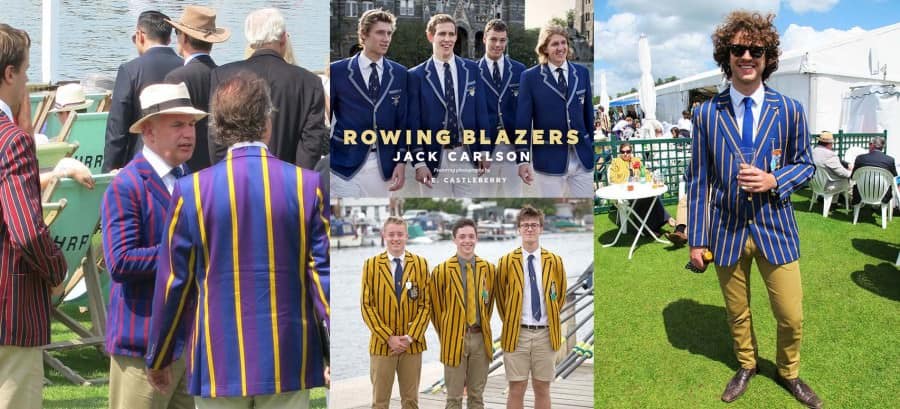
Blazer Fabrics
Navy Serge – The Classic
Navy serge is a worsted wool that is probably the most popular fabric choice for a blazer. Usually made of merino wool, it has a characteristic twill structure and in my experience it is prone to get shiny in areas of frequent friction. For this reason, be careful when ironing or dry cleaning because too much heat or direct contact with the iron will also make it look shiny in an unpleasant way. If you want a deliberately shiny blazer, look for a wool mohair blend; that looks much more sophisticated than a worn-out serge.
Hopsack
Hopsack has an open weave structure that will immediately add more texture to your outfit, but it is also much more prone to pulled threads. So if you have children, pets or often come in contact with items that could pull a thread, hopsack may not be the best choice for you.
Flannel
For winter blazers, a true wool flannel is ideal if it’s not going to be in heavy rotation. If you plan to wear the jacket frequently, opt for a worsted flannel so you can get more wear out of the blazer. Both will wear a bit warmer and the flannel nap will make it more suitable for fall & winter ensembles.
Cashmere or Vicuna
For a more luxurious alternative fabric in winter, choose cashmere or vicuna. These luxurious fabrics will look and feel beautiful, though they will cost many times more than a traditional blazer. Then again, versatile pieces are usually the best place to invest anyway!
Fresco or Linen
If you live in a place where it is always warm, you should look into linen or fresco blazers. Many men don’t like the wrinkled look of linen; others simply embrace the look. If you are not one of them, I can recommend fresco wholeheartedly.
Linen Explained – Men’s Summer Fabric Guide
Blazer Details
As mentioned before, you have plenty of choices for buttons. While gold and to a lesser extent silver buttons are most common, buttons in white or grey mother of pearl can look just as stunning as light-colored horn buttons. At the end of the day, it is entirely up to you what kind of buttons to wear, so think about it and select what feels right to you.
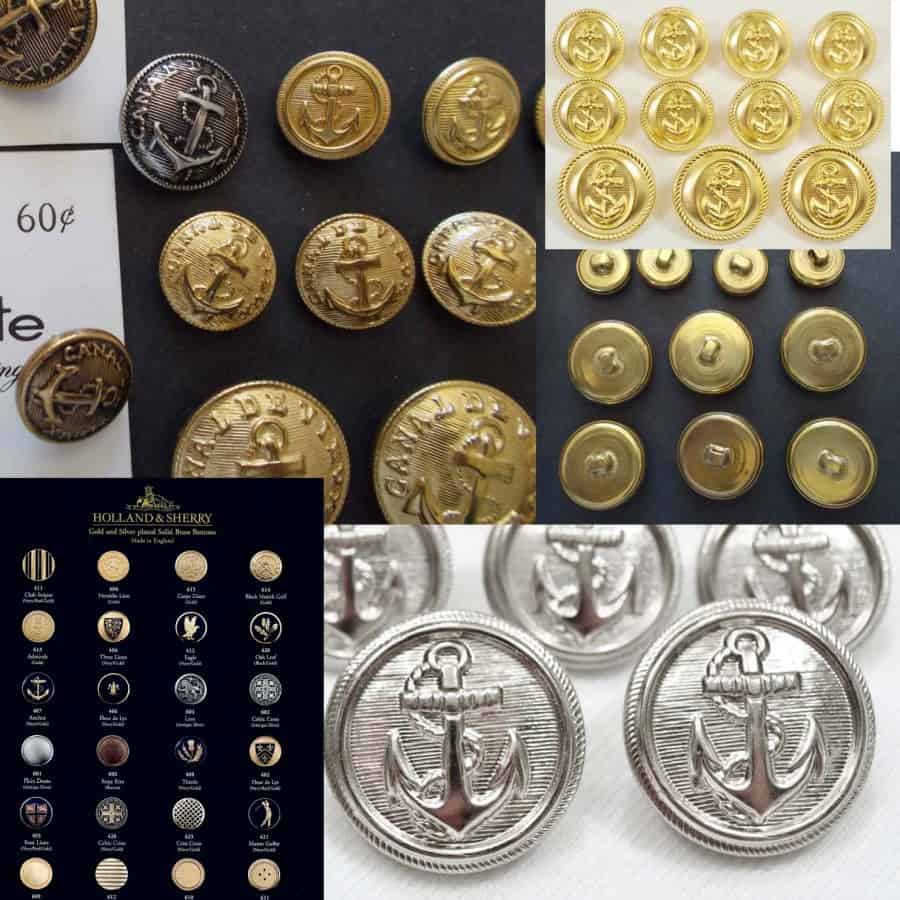
Double-breasted jackets should have peaked lapels and either a 6×2, 6×3 or 8×3 silhouette, though a 4×2 or 4×1 can look good as well. Traditionally, double-breasted blazers in navy had no vents but today most have side vents. Historically it would not make sense to have a middle vent since that was invented for horseback riding. While a classic blazer will feature flapped pockets, lately patch pockets have become rather popular.
For single-breasted jackets, I would also recommend side vents and either two or three buttons. I find patch pocket more natural but flapped pockets will work as well. In any case, go with a notched lapel. Due to its maritime roots, you will not see many blazers with action backs or belts as you may know them from the Norfolk jacket.
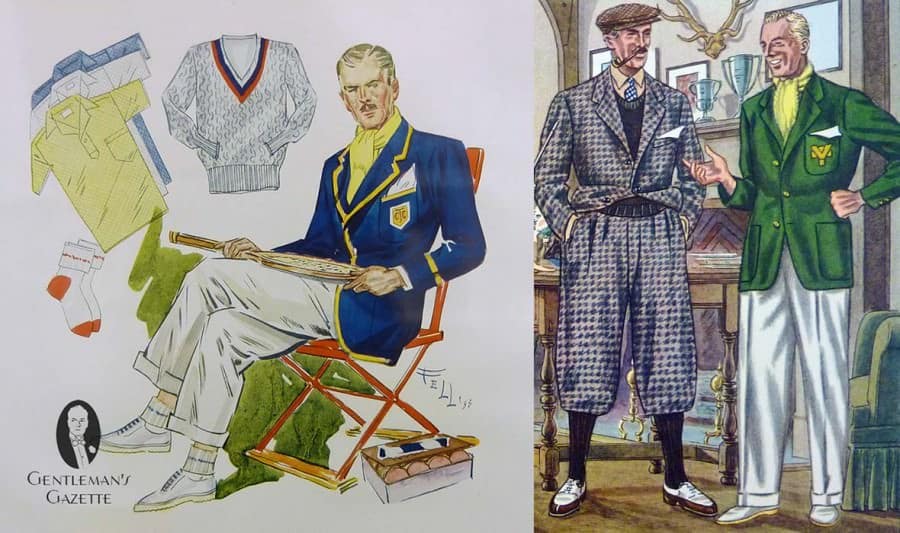
When going for a custom garment, many men seem to go for a red lining. Personally, I think a solid green or yellow lining look spectacular when combined with a navy blazer. Also, solid navy looks particularly debonair with boutonnieres of all kinds.
One last piece of advice: it is best to avoid wearing a badge or crest unless one is attending a function hosted by your club/association. On the other hand, embossed buttons are de rigueur, and they can be a great way to add a subtle, personal detail to your outfit.
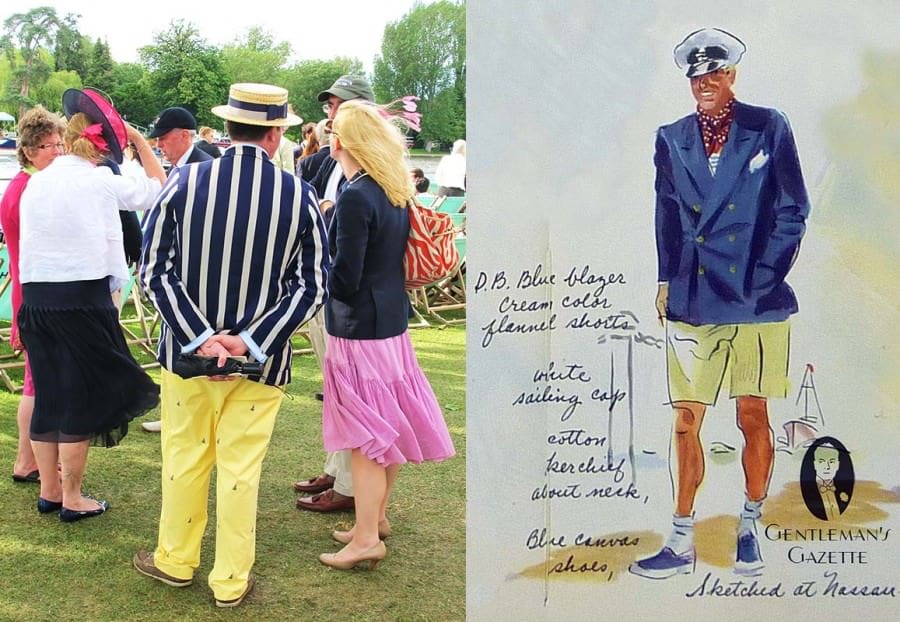
Today, striped blazers are either associated with vintage 1920s outfits or specific clubs. If you want to stand out in a classic way, the striped blazer is certainly your best choice. In my experience you can still find them in England rather regularly – either in vintage shops or custom, whereas in the US they are more difficult to find and sometimes only available when movies like the Great Gatsby become the focus of the public eye.
Fit of a Blazer
Generally, a blazer should fit like a suit jacket, though some men prefer for it to fit like a sport coat (meaning a little looser and wider with a bit more length) but other than that nothing is special here and all standard rules such as the proper sleeve length apply to the blazer as well. In terms of canvas or shoulder padding, most double-breasted blazers will have a more structured canvas and some shoulder padding, however with the popularity of the Neapolitan jacket, you will now find more unlined blazers with little to no shoulder padding and very soft interlining. As always, there is no objective right or wrong: the only thing that matters is what looks good on you and makes you feel good.
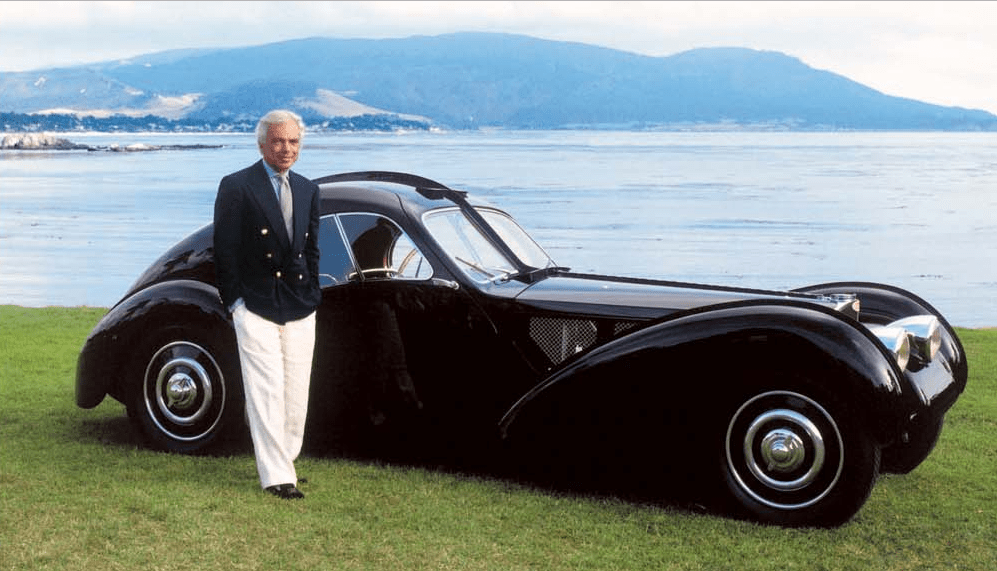
Sometimes you will find the distinction of American, English and Italian silhouette.

- American is described as two buttons, single-breasted, navy blue with soft shoulders. Notch lapels, patch or flap pockets and a single vent.
- The English style has more structured shoulders in either single or double-breasted, notched lapel in the case of single-breasted and peak lapels in case of the double-breasted cut. It will have double vents in both cases. The single-breasted will have three buttons.
- The Italian or European style differs from the others in that the fabric is usually of lighter weight and the blazer is less structured.
Personally, I don’t really find these classifications particularly helpful and consider them a relic from the 1980s, because you can find tailors in England, Europe or the U.S. that will produce an unbelievably soft jacket or a stiff military uniform and the same is true for almost any area around the globe. If you prefer a structured look, go for a stiffer canvas and if you prefer a jacket that feels more like a sweater than anything else, opt for a very soft canvas.
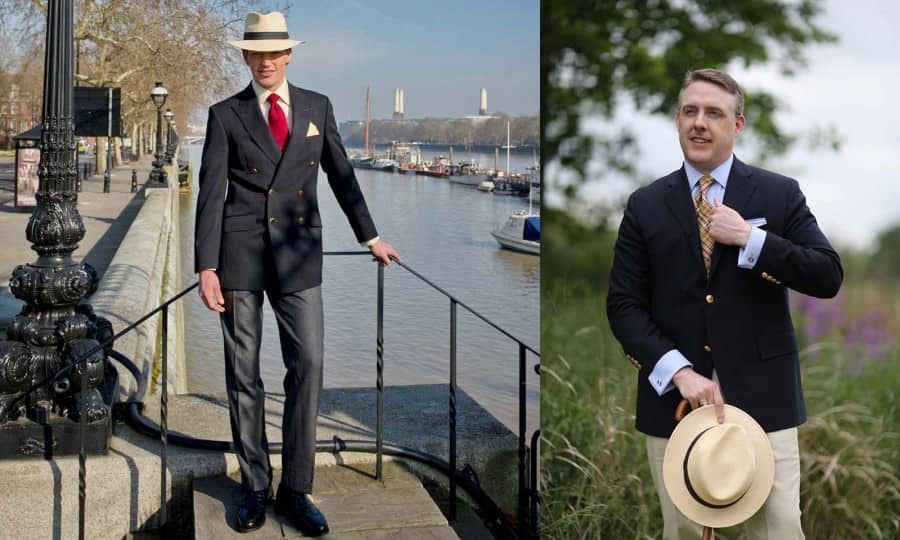
How to Combine a Blazer
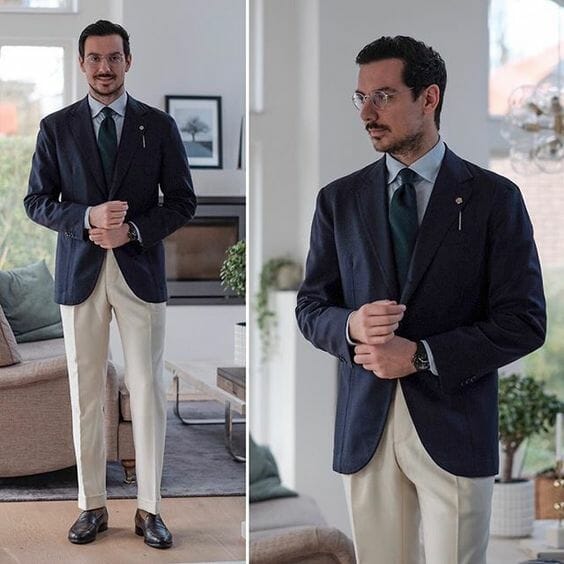
Just like vests or waistcoats, a blazer is very variable and can be worn with a number of different trousers and shirt & tie combinations.
White Flannel Trousers
For a classic 1930s look, a navy or striped blazer with white or off-white flannel trousers looks great. With a light blue oxford shirt, and green tie or ascot and maybe a cornflower or Edelweiss boutonniere, you will look very debonair. If spectator shoes in brown and white are too much for you, white buckskin shoes or shades of brown, including oxblood red will work well.
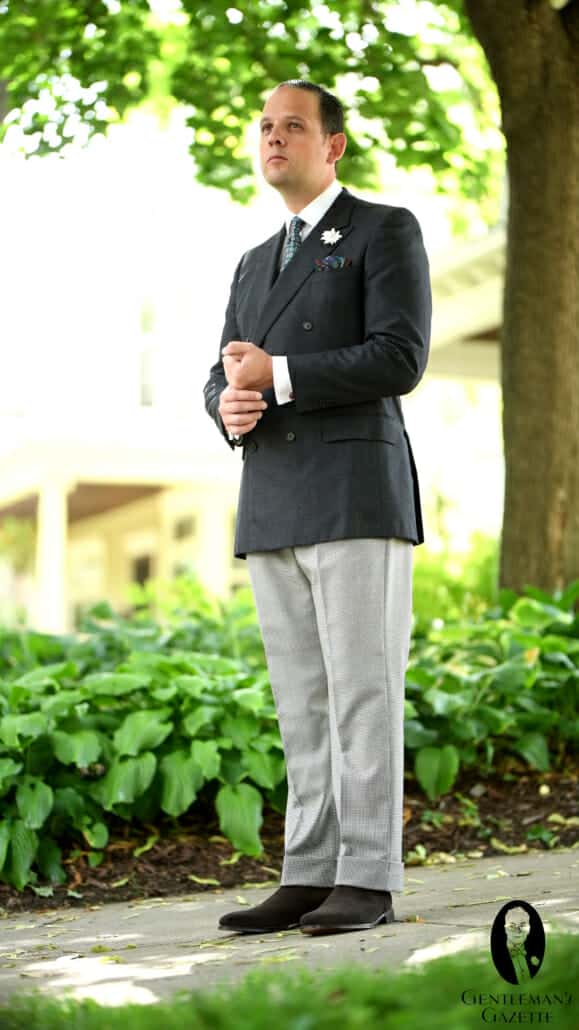
Grey or Camel Flannel & Tie
Likewise a very classic look can be achieved with grey flannel (light grey and charcoal are both fine) pants or shades of camel. Most men will opt for a crisp white shirt or a light blue one with a repp tie. Of course, pale shirt colors such as light green, lavender, pink or salmon will work just as well. For a winter outfit, a wool challis tie or real ancient madder silk tie are ideal. If you want to add a bit more texture, go for a grenadine or even better, a knit tie. For grey trousers, you should wear black oxford and light-colored shades with brown. If you have a good understanding for color, I can also recommend bottle green shoes or oxblood.
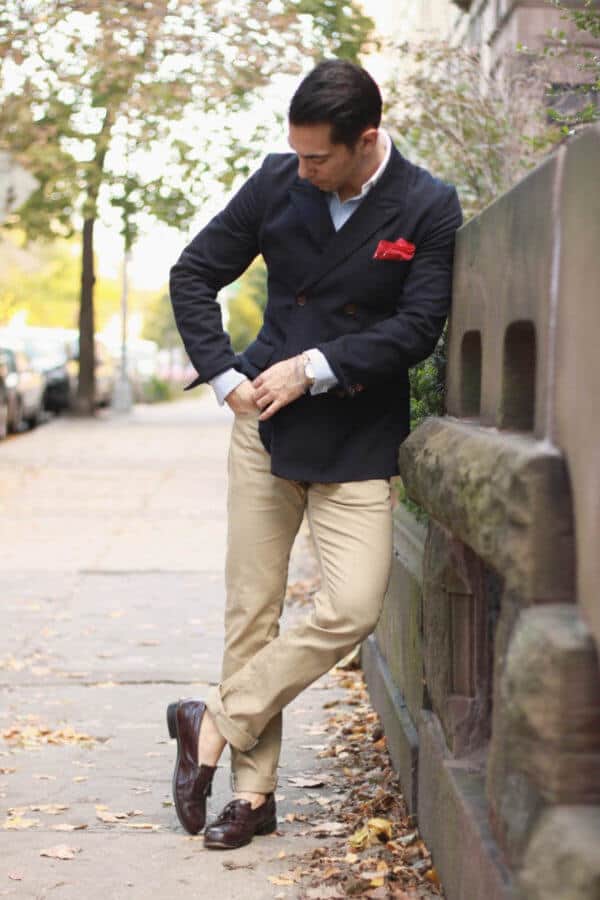
Chinos
Chinos in khaki really make navy pop, and with a shared military background it is also historically a good companion. No matter if you opt for a fuller cut with pleats and cuffs or if you prefer a flat front, narrower and shorter cut, chinos go very well with a blazer. Don’t shy away from different colors: green, yellow, light blue, Nantucket Red…they all work with a navy blazer.
Cavalry Twill & Corduroy
Most men won’t necessarily think of combining corduroy or cavalry twill trousers with a blazer but in burgundy, beige, rust or even a lighter brown – the combination can look quite stunning.
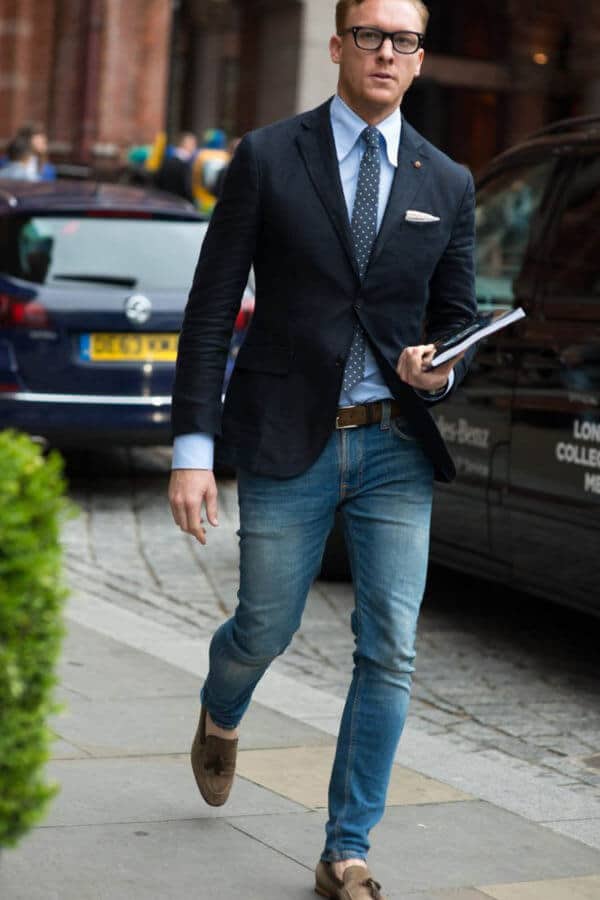
Jeans
Today, many men combine a blazer with jeans, loafers or boat shoes and a button-down oxford shirt, which is acceptable as well, and may be more appropriate for casual outings than the office.
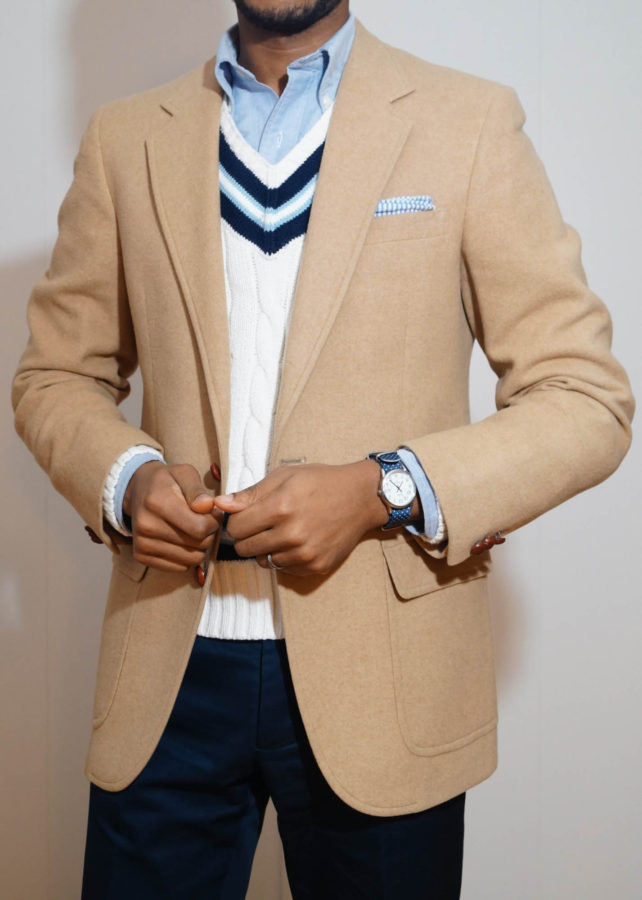
Other Options
Some men think you can combine anything with a blazer and so you will see men wearing it with t-shirts or polo shirts. Whenever you wear a jacket, I recommend to go with long sleeves, and a casual shirt or dress shirt will always beat a polo shirt and especially a t-shirt. Instead of neckties, bow ties and ascots are always a good way to individualize your blazer outfit.
Unfortunately, it would be impossible to create a definitive list of quality blazers because there are simply so many manufacturers out there. Any respectable menswear brand will carry a navy blazer as part of its standard collection.
Best Men’s OTR Navy Blazers Under $500 Reviewed
Conclusion
The blazer today is an extremely versatile garment and is considered suitable attire for any situation be it casual, business casual or business informal. It can be worn with a wide variety of other clothes ranging from a shirt and tie to open-necked shirts. If you are beginning the building of your wardrobe, bear in mind that the blazer will likely be your number one garment in terms of versatility.
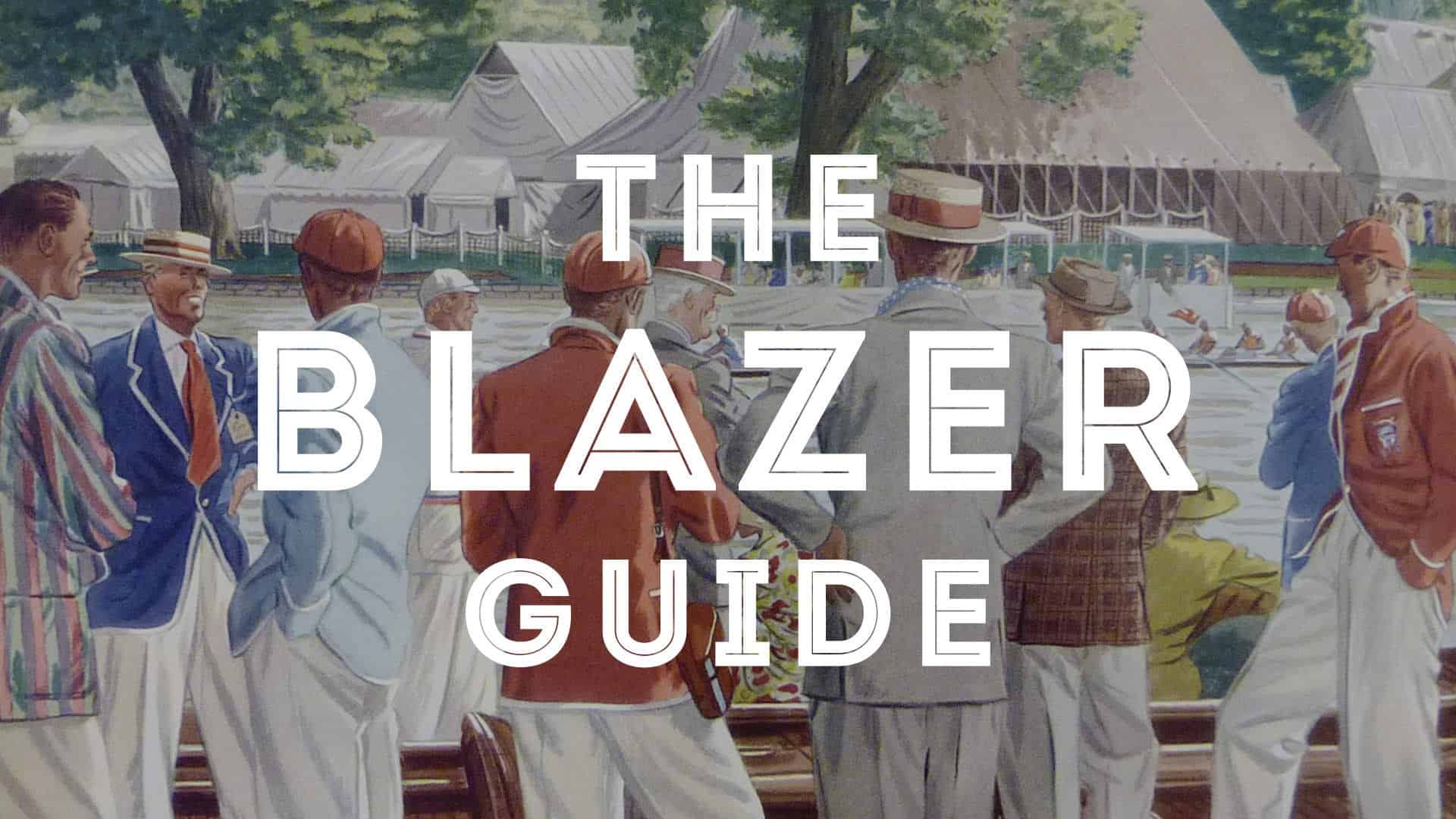

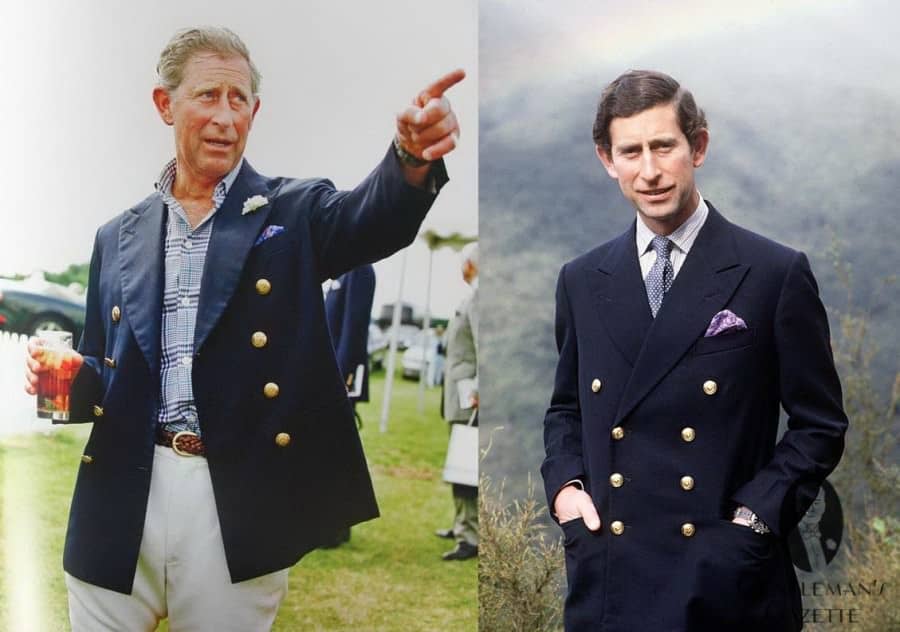
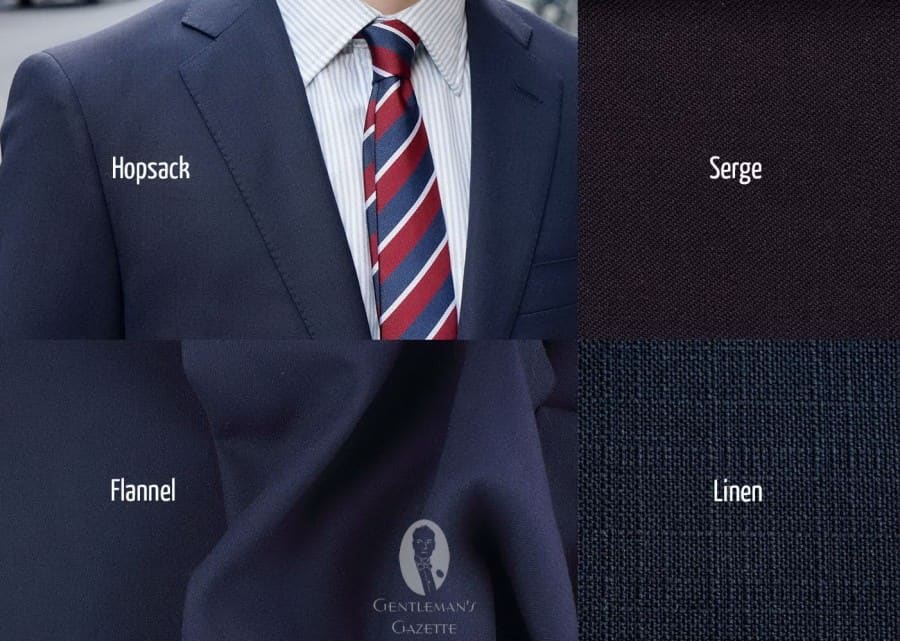
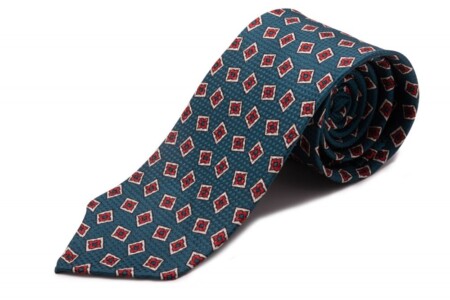
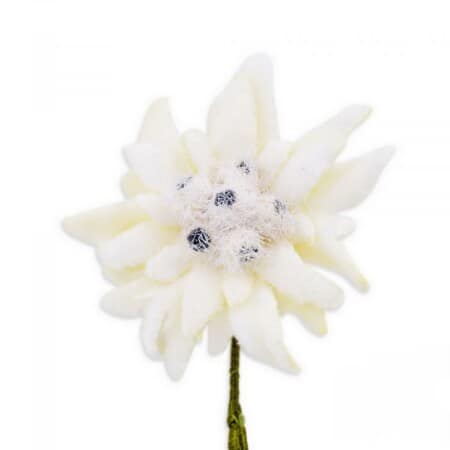
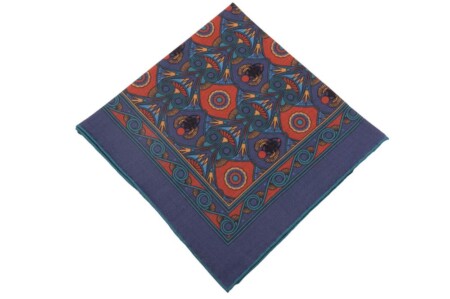
My tailor procured me a lovely wool blazer from Magee – nice heavy fabric, but still breathable.
Probably my favourite item in the wardrobe, and almost certainly the most versatile.
Please send over a picture RB.
Dear Sirs,
There is a mistake in your , very nice , article.
The Boat Club of St. John’s College , Cambridge , (GB ) is called Lady Margaret Boat Club. Lady Margaret Hall is a college in Oxford (GB ) and has , indeed ,as a rowing club the Lady Margaret Hall Boat Club based in Oxford.. You are in your article refering to the Lady Margaret Boat Club , Cambridge (GB ).
Accidently calling it the Lady Margaret Hall Boat Club !
Of course.
Good stuff…!!!
Thank you.
I never knew that the simple sports blazer had so much to them. I kept away from them due to my mother dressing me in the classic navy blue blazer with grey trousers. Now she only is aloud to buy my underwear, perhaps the occasional shirt. Never the less, I am going to explore this forgotten garment and right now leaning towards the Prince Charles 8 button set style but I do try and stay away from the military look, and so a demon that I will have to struggle with. Excellent article and keep up the good work. Speaking of the military look, could you do an article on when it is best to wear this, what the rules are and styles abound.
Mickey, I will look into the military look at some point in the future.
I actually have a pair of velvet blazers, one jet black with a single pewter button, and another charcoal grey with a purple satin lining. They were hard to come by and bought strictly for comfort, but due to their rarity I find they often positively catch an eye.
I like velvet jackets for evening occasions with matching or velvet covered buttons. Personally, I have not seen many velvet blazers, would you mind sharing a few pictures with me?
After many disappointments I have to say for fit and style Brooks Brothers is still the gold standard. I own one each in single and double- breasted; a 3/2 roll SB and 6×2 DB. Expensive but I never have to think about how they look. One other thing I’ve noticed about Brooks blazers:the buttons stay sewed on unlike cheaper blazers. It’s a small thing but it makes me happy.
Thanks for sharing your experiences with BB. Please share some pictures if you have some, thank you!
What a lovely article, thank you.
I believe the connection with the rowing club to be correct one. It was once written that the rowers “set the river ablaze with their jackets”. They now sadly no longer wear their blazers to row, it’s all head to toe Lycra.
A small detail, but I’m certain that it is called Lady Margaret Boat Club, without any “Hall”.
It definitely is.
Lady Margaret Hall is a college in Oxford unrelated to the St John’s College Cambridge boat club. The link posted also takes you to the Oxford college’s boat club, I notice.
Well done; my hat off to you sir!
Thank you!
Gentlemen,
great collaboration in this issue about blazers I find it really noteworthy the history and origin of this jacket in fact I personally own four two single breasted and two double breasted (all navy in colour) the one single breasted however is finished off with your not so typical gold or silver buttons which lead me to think maybe this jacket may be consider more of a sport coat.
I confess that I do not utilize these jackets as often as I would like for fear of not knowing how to combine them with the right accessories or wearing them to the proper occasions I will however try the recommended suggestions in the article and give new life to these jackets!
Best Regards,
Park Jacob Weatherby
Thanks for the deep post , very full of informations as always .
I love 60’s blazers and as new ones my 1ST PAT-RN jacket !
thanks Swen Raphael
Alessio Berto
You are welcome Alessio. I’d like to see some 1960’s blazers from you..
Here you can see some 1ST PAT-RN blazers we did for this winter .
thanks
Alessio
http://www.contemporarystandard.com/en/2013/06/1st-pat-rn/
Great care should be taken when selecting a blazer, especially in the UK. Many Schools, Associations and Clubs have apparently ordinary styles, which are identified to those in the know. For example my Old School Colours blazer is perfectly plain blue, with the exception of a gold wire lion rampant. Very classic, for those who are entitled to wear it!
Thanks a lot for this most enriching and insightful article. There can’t be enough articles in praise of the blazer, and this one is certainly the best to exist.
I am myself astonished every time how versatile that simple navy coat can be. Be it with grey slacks on the workplace or with bright colored chinos in sparetime, there’s nothing that this quasi “Leatherman of classical menswear” can’t do. I would suggest, though, that a single-breasted one is more versatile than a double-breasted one, with the latter being more formal and therefore less suited for casual occasions, especially for young men.
Congrats for the post! Very interesting. I love blazers and I have many of them, but this Boglioli single breasted summer jacket is my favourite one.
https://www.mrporter.com/product/328979
Appreciate your guidance. Too bad it’s falling too much on deaf ears (cf POTUS tieless interview).
Your opinion of patches (except club, school & regimental) on blazers. When I grew up they were considered tacky.
I think patches are fine if you actually need them because the jacket is worn. Adding them to a new jacket is a bit tacky but all the more popular now.
Another excellent article, Sven.
However, you don’t need to go vintage or bespoke to find a striped blazer here in the UK – they can usually be found RTW during spring and summer in any decent gentleman’s outfitters, or even in the better department stores. I haven’t taken the plunge yet myself though…
Great article! It reminds me of my navy blue blazer I wore as part of my school uniform…
The blue blazer was my staple growing up as it covered me for just about any occasion including college, except for my senior year when the business suit became apparent for interviews. Many fond memories started out in a blue blazer… The diversity of looks that were generated from it, as you mentioned from chinos to dress grey flannels and everything in between, never made me feel out of place. The investment of a better quality one is worth it just for this reason.
I do say that a button down is the correct collar for a blazer and a button cuff sleeve is appropriate but recently I’ve noticed some younger men wearing cufflink shirts and spread collars with a blazer, that just seems out of place to me. Don’t make it into something that it’s not…
The ‘American’ traditional model whether from Brooks Brothers, Hickey Freeman, Oxxford, or even Southwick all seemed to have a center hook vent [offset about 1.5″ from center and stitched to stand out as an accent], the same stitching seemed to be done on the lapel, not a hand picking but done to highlight that a blazer will never be a suit jacket as are the roll of the brass buttons I was taught. The soft shoulder and fuller body made it more of a ‘sack’ coat than the tailored suit jacket.
Foolishly, I now would have to admit to owning probably 4 or 5 of them hanging in my closet- 3 button rolled to 2, 2 button peak lapel, 6 x 2 Double Breasted, Hopsack to Worsted to twill to cover me for any occasion that requires a jacket.
That’s a lot of blazers indeed!
A marvelous article. I know not if anyone else has mentioned it, but Ben Silver in Charleston, South Carolina absolutely has one of the best selections of traditional American, English single breasted, and English double breasted blazers I have ever seen. I have nothing to do with the firm other than the fact that I bought a grand English double breasted blazer from them and had Royal Navy buttons from Gieves and Hawkes sewn on it: it’s stunningly gorgeous.
Very useful article. I had heard so many different definitions I thought it hopeless to know the difference between a sport coat and a blazer. Now I know.
Excellent article. Do you have any advice on button types for navy blazers outside the traditional brass?
Yes, just as mentioned in the article, mother of pearl is fantastic or light colored horn.
I have a navy blaxer with pewter buttons. A classic look without the high contrast of brass buttons.
Love this article – really well done! Still a bit unclear to me the difference between a blazer and a suit jacket – I have a beautiful tailor made navy blue suit – often I’ve been tempted to try using the jacket with a pair of jeans – but always fall short of confidence now that I don’t really know what distinguishes the two(!) Some more details on cuts and designs would be very helpful – what difference is there between my suit jacket and a traditional blazer? And what kind of designs should I go with for my body build? A style guide would be helpful
Thanks again for the great read – looking forward to more posts in the future
R
Excellent read!
Easily the most polite and professional comments section that i’ve come across in a long time as well.
Looking forward to exploring your website in the future.
All the best,
K
Stunning! Some of them challenging:) This is probably the never ending story I really like wearing and experimenting.
Great article, I’m actually looking to get a bespoke blazer made for me. it will be navy blue, single breasted, and have gold buttons. this will be my 1st bespoke item added to my wardrobe. any other suggestions?
How many buttons, what vents, and what blue? there are hundreds of shades of navy…
Dear Raphael and Vikram ,
May I please express my opinion ; which is only an opinion .
When it comes to having a sharp blazer or two let say because of how versatile they can be visit a tailor and have one made to your measure . The feeling one gets with a tailored garment within your wardrobe is a boon to personality .
The style of these is never far from fashionable so here is a garment a man can celebrate .
Regards
Mark
I would agree so. Nothing like a garment made solely for you.
Sven, for sping/summer, I commute on the train/subway, so I might be concerned about pulling as you mentioned in the post, and not sure if I”m a huge fan of linen due to wrinkling. About fresco – am I correct in assuming that fresco is a much more expensive fabric than hopsack or linen? Any other warm weather options you can suggest?
You freely mention flannel trousers, particularly off white. I am always on the lookout for cream flannel trousers but they are rare, indeed. Do you have any suggestions as to where one might buy them, off the peg? I don’t need help with custom as I have a very good tailor. Still, ready made trousers are what I’d like. For that matter, ANY flannel trousers are difficult to find except in grey. Thank you in advance for any assistance you may provide.
Have them tailored.
Excellent article and very timely, I wear the blazer “sports” coat at least once a week often several times a week through out t the year. I am not sure if its fashion per se’ but I’ve added a waistcoat especially during the winter months otten receive with many complementay complements.
Great video…thank you. I must , however, beg to differ with regard to your comment about side vents vs. center vents. I’ve been an equestrian for years..fox hunter and competitor in the jumper circuit. Side vents are for riding horses…NOT center vents. Not being a horseman, you probably made unintentionally this mistake. Otherwise…nice artibcle.
Greetings, a bit off topic, what are your thoughts of a Camel hair coat?
During fall/winter (I’m in Calif, no worries about rain or snow) I enjoy my camel hair. My wife on the other hand, rolls her eyes, whenever I pull out my old staple.
Hello. Do you really expect one to wear spectator shoes with that outfit? Seems like an oxymoron. I thought spectator shoes were strictly for spring/summer.